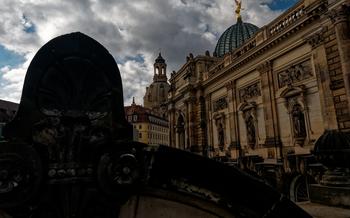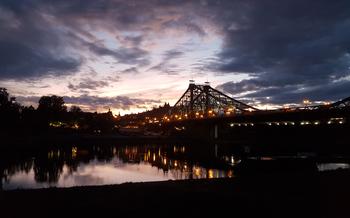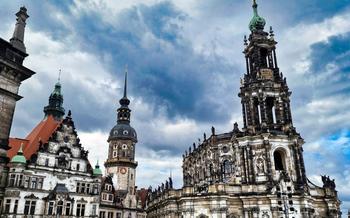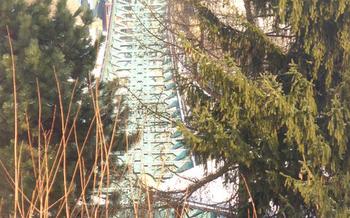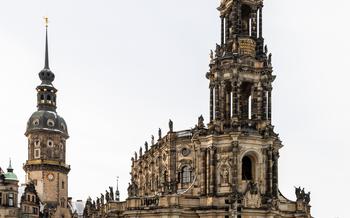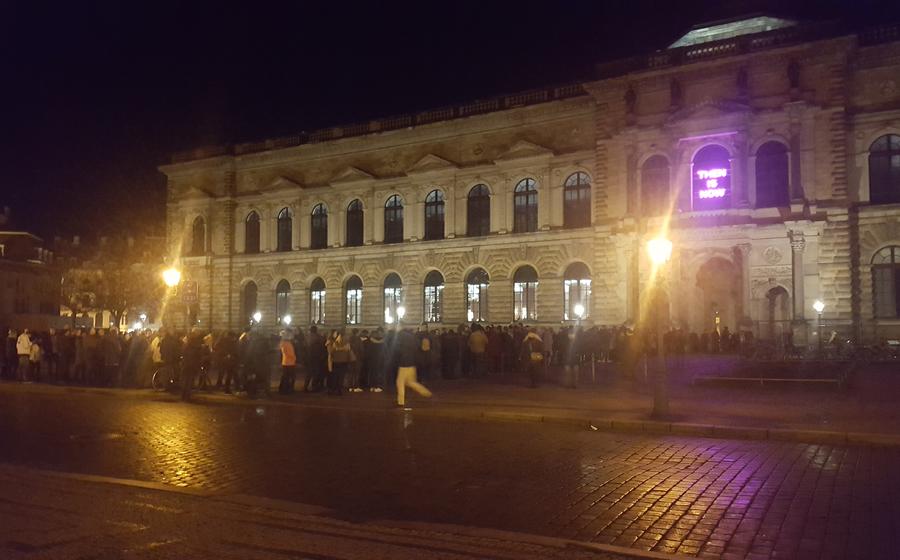
Old Masters Picture Gallery (Gemäldegalerie Alte Meister)
- The Collection
- The Building
- Architectural style and history of the building
- Notable features of the building
- Renovation and restoration work
- Accessibility for visitors with disabilities
- The Gemäldegalerie Neue Meister
- The Zwinger Palace
- The Elbe River
- The Neustadt District
- The Dresden Frauenkirche
- The Dresden Opera House (Semperoper)
- The Dresden Castle (Residenzschloss)
- The Albertinum
- The Dresden Transport Museum
- The Dresden Zoo
- The Dresden Botanical Garden
The Collection
The Gemäldegalerie Alte Meister boasts an impressive collection of paintings from the 15th to the 18th centuries, including masterpieces by some of the greatest artists in history. The collection is particularly strong in Italian and Dutch paintings, but it also features works from Germany, Flanders, Spain, and France.
Highlights of the collection include Raphael's "Sistine Madonna," which is considered one of the most beautiful paintings in the world; Giorgione's "The Tempest," a mysterious and atmospheric work that has inspired countless interpretations; and Rembrandt's "The Raising of Lazarus," a powerful and moving depiction of a biblical miracle.
Other notable artists represented in the collection include Titian, Tintoretto, Veronese, Rubens, Van Dyck, Frans Hals, and Jan Steen. Their works cover a wide range of subjects, from religious and mythological scenes to landscapes, portraits, and still lifes.
The gallery also houses a collection of drawings and prints, which can be viewed by appointment. These works provide a fascinating glimpse into the creative process of the Old Masters and offer an opportunity to see their works in a different light.
In addition to the permanent collection, the Gemäldegalerie Alte Meister also hosts temporary exhibitions throughout the year. These exhibitions often focus on a particular artist, theme, or period, and they provide a great opportunity to see new and exciting works of art.
The Building
Architectural style and history of the building
The Gemäldegalerie Alte Meister is housed in the Semper Gallery, a magnificent building that was constructed between 1847 and 185The building was designed by Gottfried Semper, one of the most renowned architects of the 19th century. Semper's design was inspired by the Italian Renaissance, and the building features a grand facade with rows of arched windows and a central pediment. The interior of the gallery is just as impressive, with a soaring atrium and a series of elegant galleries that display the paintings.
Notable features of the building
One of the most striking features of the Gemäldegalerie Alte Meister is its barrel-vaulted ceiling, which is decorated with a series of frescoes by the artist Moritz von Schwind. The frescoes depict scenes from Greek mythology and allegory, and they add a touch of grandeur to the gallery's interior. Another notable feature of the building is its grand staircase, which is made of white marble and features a bronze balustrade. The staircase is a work of art in itself, and it is one of the most photographed spots in the gallery.
Renovation and restoration work
The Gemäldegalerie Alte Meister has undergone several renovations and restoration projects over the years. The most recent renovation was completed in 2010, and it involved the restoration of the building's facade, roof, and interior. The renovation also included the installation of a new climate control system, which will help to protect the paintings from damage.
Accessibility for visitors with disabilities
The Gemäldegalerie Alte Meister is accessible to visitors with disabilities. The gallery has a wheelchair-accessible entrance, and there are elevators that provide access to all of the galleries. The gallery also offers a variety of assistive devices, such as wheelchairs, magnifying glasses, and audio guides.
The Gemäldegalerie Neue Meister
The Gemäldegalerie Neue Meister (Gallery of New Masters) is a separate museum within the Zwinger Palace dedicated to 19th-century art. While the Alte Meister focuses on the Old Masters up to the 18th century, the Neue Meister showcases works from the Romantic, Impressionist, and Expressionist periods.
The collection includes masterpieces by some of the most celebrated artists of the 19th century, such as Caspar David Friedrich, Adolph Menzel, and Max Liebermann. Visitors can admire Friedrich's iconic painting "Wanderer above the Sea of Fog" and Menzel's "The Iron Rolling Mill," which depicts the Industrial Revolution in Prussia.
Unlike the Alte Meister, the Neue Meister also features works by non-German artists, including French Impressionists such as Claude Monet and Edgar Degas. This broader scope allows visitors to trace the development of European art in the 19th century and see how German artists were influenced by their international contemporaries.
To enhance your visit, consider purchasing a combined ticket that grants you access to both the Alte Meister and the Neue Meister. This ticket offers a significant discount compared to buying separate tickets for each museum.
The Zwinger Palace
The Zwinger Palace is another architectural masterpiece located in the heart of Dresden. Built in the 18th century, the palace was originally intended to be an orangery for the Saxon court. However, it was later converted into a museum and now houses some of Dresden's most prized art collections.
The Zwinger Palace is a prime example of Baroque architecture, with its elaborate facades, ornate sculptures, and sprawling courtyards. The palace is also home to several other museums and attractions, including the Porcelain Collection, the Mathematical-Physical Salon, and the Old Masters Picture Gallery.
The Zwinger Gardens, located behind the palace, are also a popular attraction. The gardens are beautifully landscaped, with manicured lawns, colorful flower beds, and tranquil ponds. They are a great place to relax and take a break from the hustle and bustle of the city.
Tips for visiting the Zwinger Palace complex:
- Purchase a combined ticket that gives you access to all of the museums and attractions in the complex.
- Visit the palace early in the morning or late in the afternoon to avoid the crowds.
- Take a guided tour to learn more about the history and architecture of the palace.
- Don't miss the Zwinger Gardens, which are a beautiful place to relax and take a walk.
- Visit the Zwinger Christmas Market in December, which is one of the most popular Christmas markets in Germany.
The Elbe River
The Elbe River is an integral part of Dresden's history and culture. It has played a crucial role in the city's development, serving as a vital trade route and a source of drinking water. In recognition of its cultural and historical significance, the Elbe River Valley was designated a UNESCO World Heritage Site in 200
Visitors to Dresden can enjoy a variety of activities on and around the Elbe River. River cruises offer a scenic way to explore the city and its surroundings, passing by historic landmarks such as the Dresden Frauenkirche and the Zwinger Palace. For those who prefer to stay active, there are several water-based activities available, including kayaking, paddleboarding, and rowing.
The Elbe Cycle Path is a popular route for cyclists, offering a scenic and mostly flat journey along the riverbanks. The path stretches for over 1,200 kilometers, connecting Dresden with other cities and towns along the Elbe River, making it an ideal way to explore the region at a leisurely pace.
The Neustadt District
Across the Elbe River lies the Neustadt, or "New Town," a vibrant district that contrasts with the Baroque splendor of the Altstadt. Founded in the 16th century, the Neustadt was originally a separate city but was incorporated into Dresden in the 18th century. Today, it is a lively neighborhood known for its historic buildings, quirky shops, cafes, and restaurants.
The Neustadt is home to several landmarks, including the Kunsthofpassage, a unique art courtyard with colorful murals, sculptures, and fountains. The district is also home to the Kunsthalle im Lipsiusbau, a contemporary art museum, and the Deutsches Hygiene-Museum, which explores the history of medicine and hygiene.
The Neustadt is a great place to wander and explore, with its narrow streets, charming squares, and hidden courtyards. Be sure to visit the Pfund's Molkerei, a traditional dairy shop that has been in business since 1879, and the Kunsthofpassage, a unique art courtyard with colorful murals, sculptures, and fountains.
The Dresden Frauenkirche
The Dresden Frauenkirche, a majestic symbol of resilience and architectural prowess, stands as a testament to the city's indomitable spirit. Completed in 1743, this Baroque masterpiece was a beloved landmark, admired for its exceptional dome and exquisite interior. However, tragedy struck during the air raids of World War II when the church was reduced to a pile of rubble.
For decades, the ruins served as a stark reminder of the devastation and loss suffered by Dresden. In a remarkable display of unity and perseverance, the people of Dresden resolved to rebuild their cherished landmark. Through meticulous craftsmanship and unwavering dedication, the church was painstakingly reconstructed, drawing on historical plans and salvaged materials.
In 2005, after decades of tireless efforts, the Dresden Frauenkirche was reborn, its dazzling golden dome once again gracing the city's skyline. Its resurrection stands as a testament to the power of hope, the strength of community, and the enduring legacy of architectural heritage.
Today, the Frauenkirche is not only a place of worship but also a significant cultural and historical site. Visitors can marvel at its grand interior, adorned with intricate frescoes and sculptures. The church's famous organ, rebuilt using original parts, fills the space with its awe-inspiring music.
Climbing to the viewing platform atop the dome offers breathtaking panoramic views of Dresden, revealing the city's architectural tapestry and the picturesque Elbe River winding through the landscape. Guided tours provide fascinating insights into the church's history, its destruction, and its miraculous reconstruction.
The Dresden Frauenkirche is a must-visit destination for anyone interested in history, architecture, or spirituality. It serves as a poignant reminder of the fragility of our heritage and the importance of preserving our cultural treasures.
The Dresden Opera House (Semperoper)
The Dresden Opera House, also known as the Semperoper, is one of the most renowned opera houses in the world. It is named after its architect, Gottfried Semper, who designed the building in the Italian Renaissance style. The opera house was inaugurated in 1841 and quickly became one of the leading opera houses in Europe.
Unfortunately, the Semperoper was destroyed by fire in 186However, it was rebuilt to its former glory just 7 years later, thanks to the efforts of Semper's son, Manfred. The rebuilt opera house opened in 1878 and has been in continuous operation ever since.
The Semperoper is a magnificent building with a rich history. It has hosted some of the world's most famous operas, including Wagner's "Der Ring des Nibelungen" and Richard Strauss's "Salome." The opera house is also home to the Dresden Staatskapelle, one of the world's leading orchestras.
Visiting the Semperoper is a must for any opera lover. The opera house offers a variety of tours, including a behind-the-scenes tour that gives visitors a glimpse of the inner workings of this world-renowned institution.
Insider tip: If you want to experience the Semperoper at its best, try to attend a performance during the Dresden Music Festival, which takes place every summer.
The Dresden Castle (Residenzschloss)
The Dresden Castle, also known as the Residenzschloss, is a magnificent palace that has served as the home to the Saxon electors and kings for over 500 years. Located in the heart of the city, the castle complex is an impressive example of Renaissance and Baroque architecture and is one of Dresden's most iconic landmarks.
The castle's history dates back to the 13th century when it was built as a fortress. Over the years, it was expanded and remodeled, and in the 16th century, it was transformed into a magnificent Renaissance palace. In the 18th century, the castle underwent a Baroque makeover, and the interiors were decorated with exquisite frescoes, tapestries, and furniture.
The Dresden Castle was severely damaged during the Allied bombings of Dresden in World War II. However, it has been painstakingly reconstructed and restored to its former glory. Today, the castle houses several museums, including the Dresden State Art Collections, the Dresden State Museum of Prehistory, and the Dresden Coin Cabinet.
Visitors to the Dresden Castle can admire its impressive architecture, explore its museums, and learn about its rich history. The castle's courtyards and gardens are also worth a visit, offering beautiful views of the city.
The Albertinum
The Albertinum, once a mighty arsenal, is now a prominent museum complex situated in Dresden's historic city center. It was transformed into a cultural haven by the renowned architect, Gottfried Semper, in the 19th century. The Albertinum, with its elegant Renaissance Revival facade, is a masterpiece in its own right.
Inside the Albertinum, visitors are greeted by a treasure trove of art from different eras. The Sculpture Collection spans from the Middle Ages to the present day, showcasing works by renowned artists such as Tilman Riemenschneider, Giovanni da Bologna, and Auguste Rodin. Paintings from the 19th century are also prominently displayed, featuring masterpieces by Caspar David Friedrich, Claude Monet, and Vincent van Gogh.
Temporary exhibitions, often showcasing contemporary art and photography, add a dynamic element to the Albertinum's offerings. These exhibitions provide a platform for emerging and established artists to share their unique perspectives and challenge artistic conventions.
A visit to the Albertinum is not complete without ascending to the rooftop terrace. Here, visitors are rewarded with breathtaking panoramic views of Dresden's cityscape, including the Elbe River, the Frauenkirche, and the Zwinger Palace. It's a perfect spot to soak in the city's charm and capture some Insta-worthy shots.
The Dresden Transport Museum
For all things transport
The Dresden Transport Museum is a must-visit for anyone interested in the history of transportation. Located in a former roundhouse, the museum houses a vast collection of vehicles, including cars, trains, airplanes, and even bicycles. The exhibits trace the development of transportation from its earliest days to the present, with a particular focus on Dresden's role as a transportation hub.
One of the highlights of the museum is the collection of vintage vehicles, which includes a horse-drawn tram, a steam locomotive, and a replica of the first car to be built in Dresden. Visitors can also see a variety of exhibits on the history of public transportation in Dresden, including the development of the city's tram and bus network.
In addition to its permanent exhibits, the museum also hosts a variety of temporary exhibitions and events. These exhibitions often focus on specific aspects of transportation history, such as the role of transportation in World War II or the development of electric vehicles.
The Dresden Transport Museum is a great place to learn about the history of transportation and its impact on our lives. With its interactive exhibits and educational programs, the museum is a fun and informative experience for visitors of all ages.
The Dresden Zoo
The Dresden Zoo, one of the oldest and most beloved zoos in Germany, is a must-visit attraction for animal lovers of all ages. Founded in 1861, the zoo has been home to a wide variety of animals from all over the world for over 150 years. Today, the zoo is home to over 1,500 animals representing over 250 species, including lions, tigers, elephants, giraffes, zebras, and a variety of primates.
The Dresden Zoo is dedicated to providing a safe and enriching environment for its animals, and it plays an active role in conservation and research efforts. The zoo has been particularly successful in breeding endangered species, and it has helped to reintroduce several species back into the wild.
In addition to its impressive collection of animals, the Dresden Zoo also offers a variety of educational programs and activities for visitors of all ages. Guided tours, animal encounters, and interactive exhibits help visitors to learn more about the animals and their habitats. The zoo also has a playground and a petting zoo, making it a great place for families with young children.
Whether you are a lifelong animal lover or simply looking for a fun and educational day out, the Dresden Zoo is sure to have something for you.
The Dresden Botanical Garden
The Dresden Botanical Garden is a beautiful and tranquil oasis in the heart of the city. Founded in 1820, it is one of the oldest botanical gardens in Germany and boasts a collection of over 10,000 different plants from all over the world.
The garden is divided into several sections, each with its own unique theme. Highlights include the tropical greenhouse, with its lush vegetation and exotic flowers; the rose garden, with over 300 varieties of roses; and the alpine garden, with its collection of hardy plants from mountainous regions.
In addition to its plant collections, the Dresden Botanical Garden also offers a variety of educational programs and guided tours. There is also a cafe and a gift shop on site.
Whether you are interested in learning more about plants, enjoying a peaceful stroll, or simply taking a break from the hustle and bustle of the city, the Dresden Botanical Garden is well worth a visit.
Insider Tip: The best time to visit the Botanical Garden is in the spring or summer when the flowers are in bloom. However, the garden is also beautiful in the autumn when the leaves change color.


